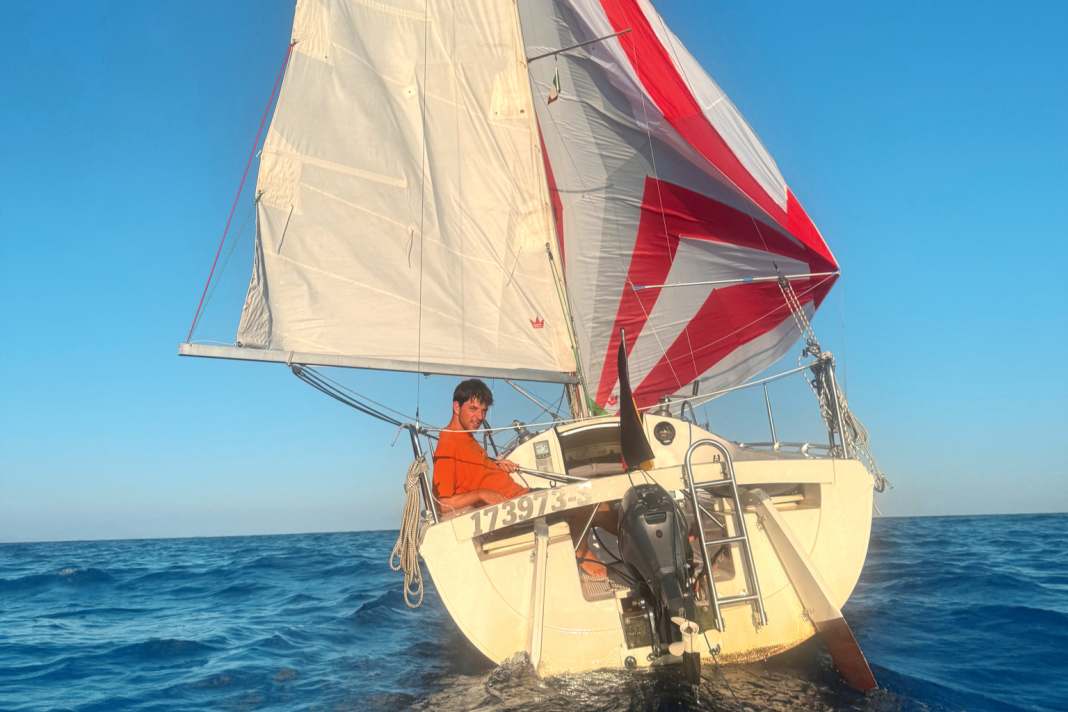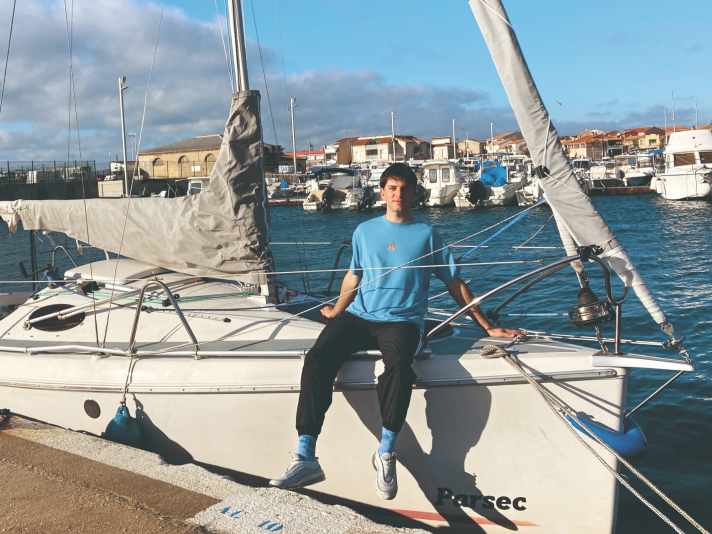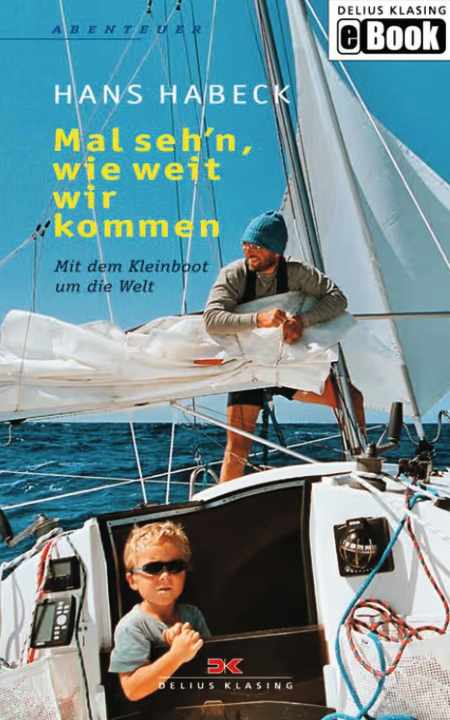





He takes a year off and travels through France to the Mediterranean in winter. He then sets off to explore the countries and islands there. After stops in Corsica, Italy and Sicily, he has now reached Zakynthos in Greece. In this interview, Luca Jehle talks about his trip so far, life, living and travelling on a small boat.
Also interesting:
YACHT: Luca, you sail your six-and-a-half metre boat through the Mediterranean. What are the reactions like when you arrive somewhere?
I really am an absolute exception here. When I meet other small boat sailors, they are mostly from here. Otherwise it tends to start at 30 feet. A harbour master couldn't believe it the other day and actually asked me to get the boat documents. When he saw that I was really travelling at 21 feet, he didn't know what to charge and asked what I would pay elsewhere. Now it's 3.60 euros per night.
How do the sometimes steep berthing costs in the Mediterranean fit in with your travel budget?
One of the biggest challenges of the journey is making ends meet with the 500 to 600 euros I have available each month. I can continue my mini-job from my studies online on the side. But I deliberately don't want to work more so that I can enjoy my time here.
Does that mean you earn your entire travel budget on the road?
In the meantime, yes. Almost everything I had saved in advance went into the boat and the preparation. Then I set off with a buffer of 1,000 to 2,000 euros.
The Mediterranean is considered quite expensive. What monthly costs do you have to reckon with?
It's incredibly varied. When I'm on my own, I try to only call at a harbour once a week. That's how long I can manage without electricity, new water and sometimes internet. The prices in the harbours vary.
Where has it been the most expensive so far?
In the Bay of Naples, by far. 150 euros per night is simply far too much. The contrast is enormous.
Does something like that detract from your travelling experience?
I actually found the Bay of Naples to be a sailing wasteland. Beyond that, however, the destinations are all beautiful.
Where have you enjoyed it the most so far?
Difficult! The Côte d'Azur, Monaco, Corsica - that was a really nice place. I got to know interesting people there and therefore stayed a little longer than originally planned, a good two weeks. The Aeolian Islands with the volcanoes were of course also great. And Malta!
Do you follow a set route or do you sail wherever the wind takes you?
When I set off, my goal was to get as far as Corsica and maybe spend the winter there. I didn't want to plan too much in advance because I wasn't quite sure how I would get on. My route so far actually included everything I wanted to see.
Are you only travelling alone?
No, I've already had five people on board who have stayed for ten to fourteen days each. I even got to know some of them en route.
Does sailing with several people on the small boat work?
I hadn't planned it, but it just happened. I met someone on Elba who had just completed his SKS licence there and didn't want to go back home. We got on well - then he actually came with me for three weeks. We sailed together from Rome to Catania in Sicily. That worked! Once we even sailed as a threesome, but the boat was really full. One or two people is an acceptable limit. Everything else only lasts a few days.
And certainly only in good weather. Why did you choose the Mediterranean for this sailing holiday?
The Mediterranean is a treasure with its natural and cultural diversity. You drive a few miles and it feels like you're always seeing something new. I'm only really realising that now, while I'm travelling here. In the end, however, I decided quite spontaneously. Before the start, I lived in Heidelberg. I liked the idea of setting off from there on my own keel on the Neckar and then making my way north or south.
How was the start, the inland journey across rivers and canals through France to the Mediterranean?
Unfortunately, I didn't set off until the beginning of October 2023. I was supposed to start earlier, but I still had a few things to do. I crossed over into the Saône with the last lock at the end of October. My boat doesn't have proper diesel heating. The idea was to head south with the climate so that it's always reasonably warm in the boat.
Did the plan work out?
The journey on the canals was very long. A friend accompanied me on the route - we passed around 120 locks. That's a substitute for any gym! You have to lend a hand in the small locks. At some point, winter caught up with us and there was frost on the boat in the morning. Moisture quickly becomes a problem. We sat below deck with a hot water bottle, tea in hand and had the cooker on for a while. Outside, I manoeuvred us through the locks in my winter jacket. And all this with the mast lowered on deck to fit under the bridges.
That sounds like a real winter adventure. Would you do it again?
It was a great experience. It's doable and was nice, but I wouldn't do it again. Maybe the timing was just wrong.
In return, you were rewarded with a lot of warmth on arrival in the Mediterranean when it was a cold winter in Germany.
That's right. I arrived in Port Napoléon exactly on 24 December. That was my Christmas present - but it was a coincidence!
Did you then take a breather or did you carry on straight away?
Fact straight away! Of course, I took a few days to set the mast, hoist the sails and so on. Then it was off towards Marseille and along the Côte d'Azur. In the Golfe du Lion, I got caught out straight away - it can be very uncomfortable in winter.
What happened?
It was actually just a coastal trip. The forecast was for strong winds, but they turned out to be stronger than expected. It was cold and I estimated the waves at two metres. Apparently that was too much for my boat and the lug fitting broke. So I didn't have a mainsail for a while until everything was repaired. That was really annoying.
Have you been surprised by the Mediterranean weather more often?
Not really, except for this situation. I realised how important it is to consider the local wind systems in addition to the weather forecast. Like the jet effect between Sardinia and Corsica. Or the land wind-sea wind system. Or local winds such as the Mistral or downbursts.
Was the breakage of the lollipop fitting the only material damage and setback on the journey?
On the way through France, I hit a drifting tree trunk that tore off one of my rudder blades. This is one of the disadvantages of my Etap: the twin rudder system is quite exposed.
Are you still happy with your choice of boat? You chose the Etap 21i for a very special reason.
That's right. When thinking about what it should be, I got stuck on one of my favourite books about sailing: "Let's see how far we get". In it, the Habeck family describe how the three of them made it around the world on this boat, which is effectively unsinkable. The apparently good sailing and living characteristics simply won me over. It even proved its worth before I set off, when I moved out of my shared flat during my final year of university and lived on board on the Neckar in Heidelberg. It was cheap and gave me a financial buffer for the trip.
Have you ever considered another boat?
No, I wanted this super combination: a sporty sailing boat with a great layout and cosy elements inside - sleeping area, table, kitchen. I even have a sea toilet! In other words, everything that is relevant for a trip like this. It was the boat or no boat!
How did you prepare for your big trip? Was there a lot to do?
No, that was limited. I did have to sand down the old hard antifouling, then prime it again and apply new paint. I also cleaned and coloured the upholstery, did some woodwork, applied new anti-slip paint, checked the running rigging and things like that.
The Etap is your fourth boat. What sailing experience did you have before this trip?
My biggest tour before that was on the North Sea coast. I took half a year off after my A-levels to go sailing. I started near Wilhelmshaven and came out in Amsterdam. It was great and I learnt a lot. That was my reward to myself for having also trained as a paramedic during my A-levels, including night shifts and hospital placements at the weekend.
What kind of boat did you take on this North Sea trip back then?
That was on a Sailart 18 and it was just such a great time! Now, after my bachelor's degree, I had the luxury of not starting my master's programme until a good year later, so I was able to plan for such a break financially. So I finally decided to use the time to go sailing again - even though my bachelor's thesis wasn't quite finished at the time.
So you locked it on the way?
Exactly, I sent them to print when I was anchored in Corsica.
Have you always dreamed of such trips on your own keel?
On the contrary, for a long time I had no connection to sailing at all! I come from Ulm, where the Danube flows, but it's a sailing wasteland. But I've always liked the principle of sailing because I'm fascinated by the idea that you can get more or less anywhere with just the wind.
And how did you end up on the water?
At some point I did a sailing course on Lake Constance for a week. Since then, I've stuck with it and completed my sailing licences up to SKS. I quickly realised that I wanted to be able to handle the nautical chart and the radio and that I enjoyed cruising much more than sailing back and forth from the harbour.
So the step to owning your own boat wasn't that big?
Exactly, I started with a dinghy, but I didn't grow old with it. The next boat was the Sailart 18, which I restored more extensively. And then there's my kayak.
Have you already been on a long trip with it?
I once started out with it in Heidelberg and paddled all the way to the Netherlands. But now I use it as a dinghy on my Mediterranean trip. That works great! Even though it's only a single-seater and one of us has to swim ashore when there are two of us. Then we flip a coin. (Laughs.)
Do you miss something? After almost a year on the small boat, do you perhaps feel the need for a little more comfort?
I really miss having an autopilot or a wind steering system on board. That would do a lot for me. But that was no longer in my budget. I'm also looking forward to a new shared room when I get back. Hanging a picture on the wall again, being able to stand upright and turn in circles, that will be good!
You are still travelling. When and where will this journey end?
I still have time until the autumn. I'll soon be travelling through the Strait of Corinth and then probably via some Greek islands - Mykonos, Delos, Naxos, Santorini - to Crete. Then on via Kythira to the Peloponnese. From there I'll fly back to pick up the trailer and bring the boat back.
What are your future sailing plans? Like the Habecks, a circumnavigation in the Etap?
No, not that. (Laughs.) But I will definitely keep the boat. I've already seen a lot of great places in Europe. I'll definitely take another look at some of them.
The skipper and his boat

Luca Jehle is 26 years old. He completed a bachelor's degree in geosciences in Heidelberg. He is using the time until the start of his Master's programme to go on a small-cruise cruise through the Mediterranean. He sails single-handed for long stretches.
His boat is an Etap 21i, built in 2000, which is 6.56 metres long, 2.49 metres wide, has a fixed keel with a draught of 0.70 metres and a double rudder system. The sails for the trip consist of a mainsail, jib and a code zero as a light wind sail. The small cruiser is motorised with a 10 hp Yamaha outboard engine.
The journey in figures
- Distance: more than 1,800 nautical miles in the Mediterranean, a total of 2,300 since departure
- Countries travelled on own keel: 6 (Germany, France, Monaco, Italy, Malta, Greece)
- Islands: 26
- Locks: 12
- visited museums: 15
- Longest time alone at sea: 3 days
Book tip

Around the world with the Etap: In his travelogue "Mal seh'n, wie weit wir kommen" (Let's see how far we get), father Hans Habeck reports on his family's long voyage on an Etap 21i. The book was published by Delius Klasing in 2012 and available as an e-book.

